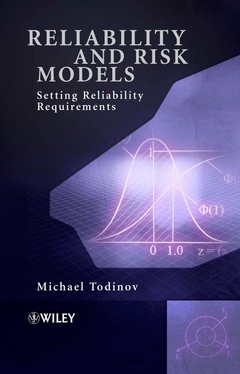Reliability & risk analysis models : setting quantitative reliability require ments
Auteur : TODINOV Michael

1 SOME BASIC RELIABILITY CONCEPTS.
1.1 Reliability (survival) Function, Cumulative Distribution and Probability Density Function of the Times to Failure.
1.2 Random Events in Reliability and Risk Modelling.
1.2.1 Reliability of a System with Components Logically Arranged in Series.
1.2.2 Reliability of a System with Components Logically Arranged in Parallel.
1.2.3 Reliability of a System with Components Logically Arranged in Series and Parallel.
1.3 On Some Applications of the Total Probability Theorem and the Bayes Transform.
1.3.1 Total Probability Theorem. Applications.
1.3.2 Bayesian Transform. Applications.
1.4 Physical and Logical Arrangement of Components.
2 COMMON RELIABILITY AND RISK MODELS AND THEIR APPLICATIONS.
2.1 General Framework for Reliability and Risk Analysis Based on Controlling Random Variables.
2.2 Binomial Model.
2.3 Homogeneous Poisson Process and Poisson Distribution.
2.4 Negative Exponential Distribution.
2.4.1 Memoryless Property of the Negative Exponential Distribution.
2.4.2 Link Between the Poisson Distribution and the Negative Exponential Distribution.
2.4.3 Reliability of a Series Arrangement, Including Components with Constant Hazard Rates.
2.5 Hazard Rate.
2.5.1 Difference between a Failure Density and Hazard Rate.
2.6 Mean Time to Failure (MTTF).
2.7 Gamma Distribution.
2.8 Uncertainty Associated with the Mean Time to Failure.
2.9 Mean Time Between Failures (MTBF).
2.10 Uniform Distribution Model.
2.11 Gaussian (Normal) Model.
2.12 Log Normal Model.
2.13 The Weibull Model.
2.14 Reliability Bathtub Curve for Non Repairable Components/Systems.
2.15 Extreme Value Models.
3 RELIABILITY AND RISK MODELS BASED ON MIXTURE DISTRIBUTIONS.
3.1 Distribution of a Property from Multiple Sources.
3.2 Variance of a Property from Multiple Sources.
3.3 Variance Upper Bound Theorem.
3.3.1 Determining the Source Whose Removal Results in the Largest Decrease of the Variance Upper Bound.
3.3.2 Modelling the Uncertainty of the Charpy Impact Energy at a Specified Test Temperature.
3.4 Variation and Uncertainty Associated with the Charpy Impact Energy at a Specified Test Temperature.
Appendix 3.1.
Appendix 3.2 An Algorithm for Determining the Upper Bound of the Variance of Properties from Sampling from Multiple Sources.
4 BUILDING RELIABILITY AND RISK MODELS.
4.1 General Rules for Reliability Data Analysis.
4.2 Probability Plotting.
4.2.1 Testing for Consistency with the Uniform Distribution Model.
4.2.2 Testing for Consistency with the Exponential Model.
4.2.3 Testing for Consistency with the Weibull Distribution.
4.2.4 Testing for Consistency with the Type I Extreme Value Model.
4.2.5 Testing for Consistency with the Normal Distribution.
4.3 Estimating Model Parameters Using the Method of Maximum Likelihood.
4.4 Estimating the Parameters of a Three Parameter Power Law.
4.4.1 Some Applications of the Three Parameter Power Law.
5 LOADâ STRENGTH (DEMANDâ CAPACITY) MODELS.
5.1 A General Reliability Model.
5.2 The Loadâ Strength Interference Model.
5.3 Loadâ Strength (Demand Capacity) Integrals.
5.4 Calculating the Loadâ Strength Integral Using Numerical Methods.
5.5 Normally Distributed and Statistically Independent Load and Strength.
5.6 Reliability and Risk Analysis Based on the Loadâ Strength Interference Approach.
5.6.1 Influence of Strength Variability on...
Date de parution : 03-2005
Ouvrage de 288 p.



